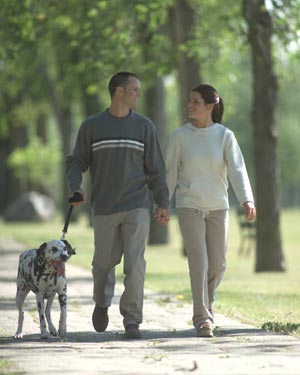Perfume of Perfection in the Burbs
Like the perfume of perfection, the suburb is a concauction of the utopian environment.
Please read further for a study of these results.
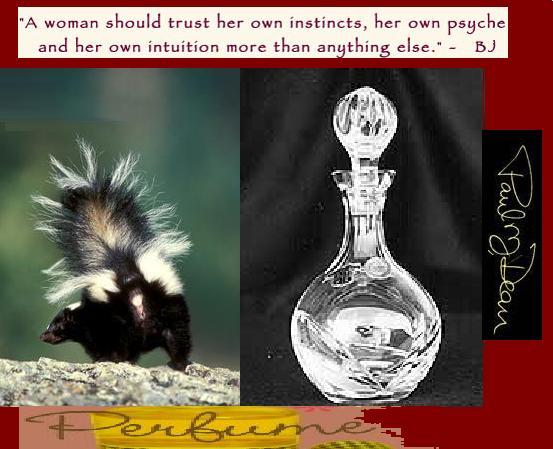
I think I just found out the new ingrediant in that expensive
perfume you have been wearing... It's the cookie cutter approach...
Cul-de-sac Community
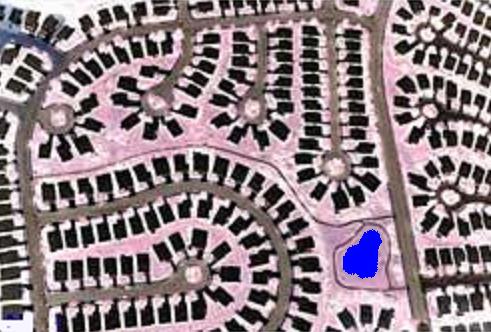 Like the perfume of perfection the suburb is a concauction of the utopian environment.
Please read further for a study of these results.
Like the perfume of perfection the suburb is a concauction of the utopian environment.
Please read further for a study of these results.
The Perfume of Perfection in Utopia
(41 percent) of pheromone users reported more petting, kissing and affection with
partners,” New Scientist magazine said on Wednesday.
Pheromones are naturally occurring chemicals found in animals and humans which
elicit sexual behaviors and are used to attract the opposite sex. Scientists have
succeeded in identifying, isolating, and recreating this human sex pheromone. These
natural pheromones have been well documented to trigger very powerful sexual
responses!
Unlike fragrances, which are detected by the Olfactory Glands in the nose, Pheromones
are detected by the Vomeronasal Organ or VNO. The VNO is located in the Nasal Pit
directly under the nose. When the VNO receives a pheromone signal it sends a message
to the brain that stimulates the body and creates a subconscious increase in sexual
desire.
The most expensive perfume in the world, Clive Christian's No.1 contains the
"finest" (for 2,000 bucks it better be) sandalwood and Indian jasmine. The women's
version also incorporates bergamot, lime, mandarin and white peach vitessence,
while the men's scent has notes of cedarwood and cardamon oil. The 30 ml bottles
feature a white brilliant cut diamond on their necks. And one secret ingrediant!
Other possible benefits of using synthetic pheromones are being studied in different
fields currently. For example, instead of using pesticides, can we instead use pheromones
from insects to stop the process of mating? Or would the animals undergo some so rt of
mutation, making them resistant to their old chemical signals, and develop a slightly
different one? There are still many questions out there about these natural chemical
signals which are released by organisms. Are they of more benefit than we th ink? Or
are we making them out to be more than they really are? For now, only time and tedious
research will tell.
1950's Circa

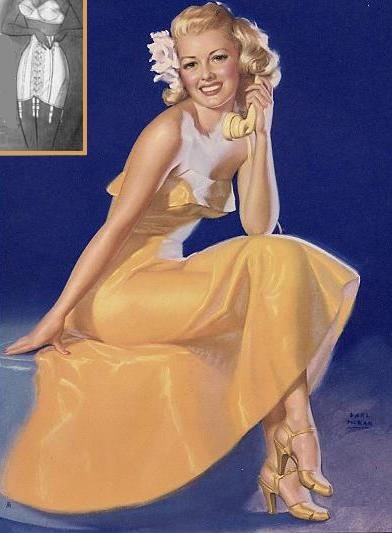

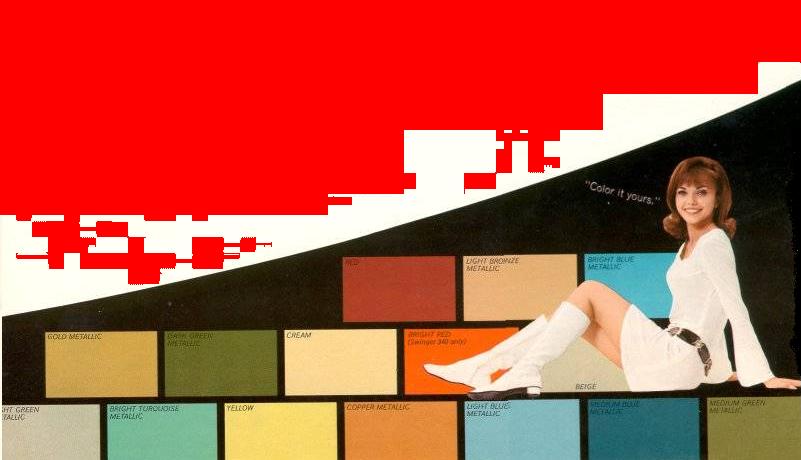
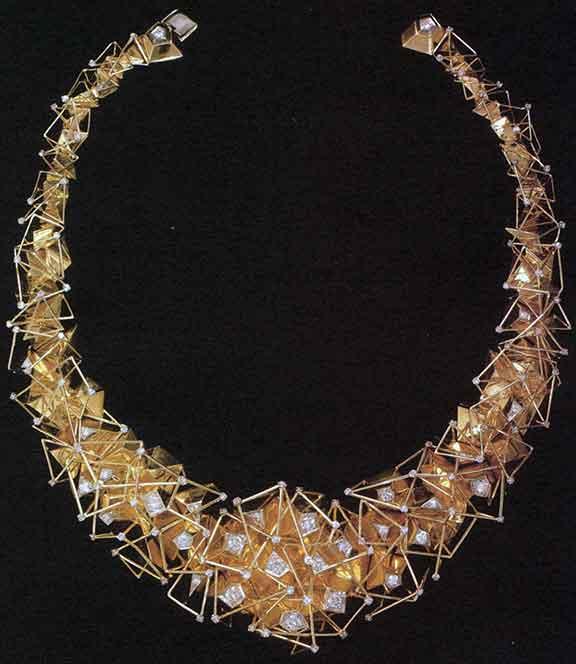
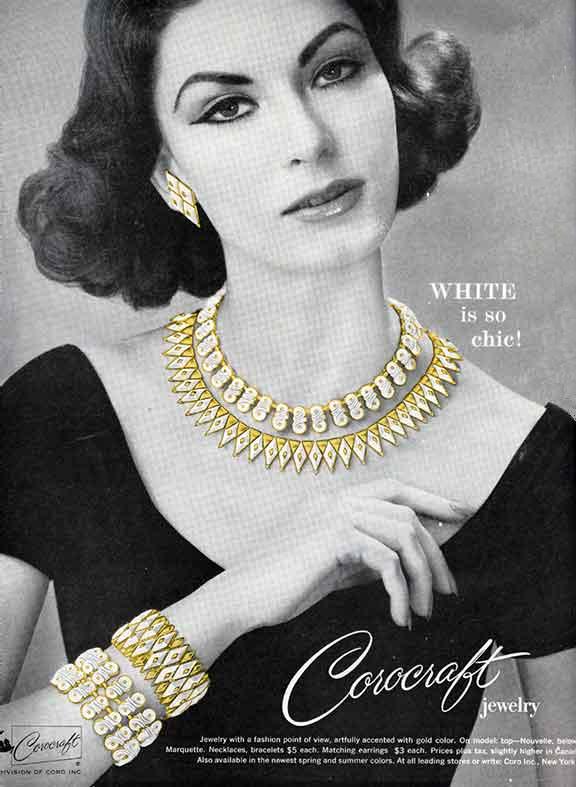
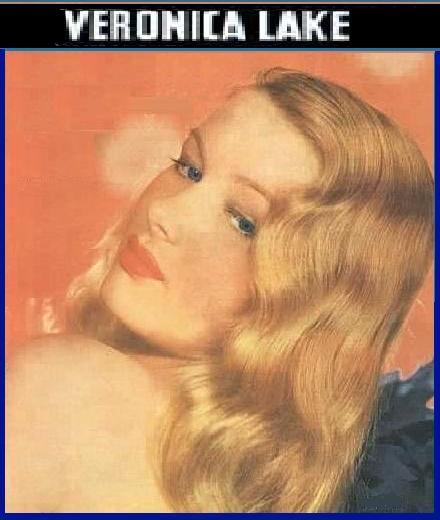 History is told in Many Ways (1950's Circa)
A lot of times we think of history as just being in the form of documents and
photographs and official pieces of legislation. But in fact, buildings and signs
and roadside architecture as well as outfits and ideas can be thought of as just
as much a statement as the documents that created them. They're telling us about
the past. They're telling us about who we were, and what type of palette of tools
we use and these architectural landmark documents tell us about who we are.
History is told in Many Ways (1950's Circa)
A lot of times we think of history as just being in the form of documents and
photographs and official pieces of legislation. But in fact, buildings and signs
and roadside architecture as well as outfits and ideas can be thought of as just
as much a statement as the documents that created them. They're telling us about
the past. They're telling us about who we were, and what type of palette of tools
we use and these architectural landmark documents tell us about who we are.
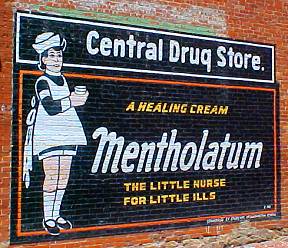
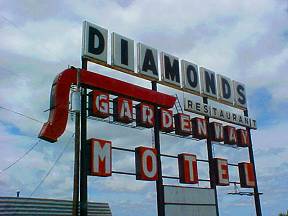 Community Building Styles and the New Landscape
We can see when a particular community started reaching out to the motoring public.
When there is more of a Tudor Revival style, that's probably more mid 20's. When
the Art Deco, Art Modern is shown, that's probably late 20's into the early 30's.
So the styles become a gauge then as to when a community starts looking at the car
as an important part of the local business and a part of the community landscape.
One of the features of 1950's-era architecture is a real focus on sharp angles, sharp
lines. Not a lot of detail, not a lot of ornamentation. When you see this style of
structure it's guaranteed that you're looking at a community that's trying to cater
to a 1950's-era motoring public.
Art Modern style building. Notice how simple it is. There's that curved wall there
at the corner. Lots of glass, much more open in feel than the boxy look of the mission
or the revivals. Everything is built to accommodate the car as being at the forefront
of community life.
The Suburb in 1950 Southern California - Pre-Subdivision
In 1948, suburban expansion was spurred by the creation of the Federal Housing
Administration (FHA), which provided mortgage insurance to families who wanted
to renovate or build homes. Soon after, the (VA) Veterans Administration home loan
program was created, offering low-interest and long-term mortgages with low down
payments to returning GIs after World War II. In 1956 the Interstate Highway Act was
created, requiring 37,000 miles of roadways to be constructed around 182 cities
in case of an invasion, created for the defensive purposes of the transportation
of troops. The system of roads from cities to the outlying areas allowed for
previously open space to be developed. These three movements have encouraged
suburban expansion throughout the nation, which gave this new type of cul-de-sac
lifestyle which was not available in earlier communities.
Semantics of the Suburb:
The word "suburb" is derived from the Old French "sub(b)urbe" and ultimately from the
Latin "suburbium," formed from "sub," meaning "under," and "urbs," meaning "city."
The word "suburb" usually refers to a separate municipality or an unincorporated area
outside of a central city.
The subdivision was too big to work as a neighborhood and so it is built as a
new form of American community, an extended cluster of neighborhoods with "village
centers" to hold the elements together. In doing this, he was drawing on much of the
urban theory architects and builders had read during the long and empty years of the
Depression.
Postwar (Kaiser Car-1946)
Community Building Styles and the New Landscape
We can see when a particular community started reaching out to the motoring public.
When there is more of a Tudor Revival style, that's probably more mid 20's. When
the Art Deco, Art Modern is shown, that's probably late 20's into the early 30's.
So the styles become a gauge then as to when a community starts looking at the car
as an important part of the local business and a part of the community landscape.
One of the features of 1950's-era architecture is a real focus on sharp angles, sharp
lines. Not a lot of detail, not a lot of ornamentation. When you see this style of
structure it's guaranteed that you're looking at a community that's trying to cater
to a 1950's-era motoring public.
Art Modern style building. Notice how simple it is. There's that curved wall there
at the corner. Lots of glass, much more open in feel than the boxy look of the mission
or the revivals. Everything is built to accommodate the car as being at the forefront
of community life.
The Suburb in 1950 Southern California - Pre-Subdivision
In 1948, suburban expansion was spurred by the creation of the Federal Housing
Administration (FHA), which provided mortgage insurance to families who wanted
to renovate or build homes. Soon after, the (VA) Veterans Administration home loan
program was created, offering low-interest and long-term mortgages with low down
payments to returning GIs after World War II. In 1956 the Interstate Highway Act was
created, requiring 37,000 miles of roadways to be constructed around 182 cities
in case of an invasion, created for the defensive purposes of the transportation
of troops. The system of roads from cities to the outlying areas allowed for
previously open space to be developed. These three movements have encouraged
suburban expansion throughout the nation, which gave this new type of cul-de-sac
lifestyle which was not available in earlier communities.
Semantics of the Suburb:
The word "suburb" is derived from the Old French "sub(b)urbe" and ultimately from the
Latin "suburbium," formed from "sub," meaning "under," and "urbs," meaning "city."
The word "suburb" usually refers to a separate municipality or an unincorporated area
outside of a central city.
The subdivision was too big to work as a neighborhood and so it is built as a
new form of American community, an extended cluster of neighborhoods with "village
centers" to hold the elements together. In doing this, he was drawing on much of the
urban theory architects and builders had read during the long and empty years of the
Depression.
Postwar (Kaiser Car-1946)
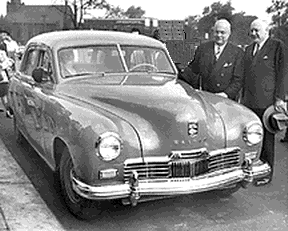 The Postwar American Suburb
Historian Robert Fishman calls American suburbia a "bourgeois utopia," whose hopes
for community stability were founded "on the shifting sands of land speculation,"
backed up by racially discriminatory covenants and lending standards. The postwar
American suburb, each a Nueva Germania of the soul, organized men's life around commutes
and women's life around the home: the result was absent fathers, isolated mothers, and
alienated children, who seldom knew anyone of a different race. In providing for the
material needs of the growing middle class, the suburb created social and spiritual
cavities that numerous social movements-from the 1960s New Left to today's Christian
fundamentalism-have tried to fill.
Cookie Cutter Garage Door Houses in Suburb
The Postwar American Suburb
Historian Robert Fishman calls American suburbia a "bourgeois utopia," whose hopes
for community stability were founded "on the shifting sands of land speculation,"
backed up by racially discriminatory covenants and lending standards. The postwar
American suburb, each a Nueva Germania of the soul, organized men's life around commutes
and women's life around the home: the result was absent fathers, isolated mothers, and
alienated children, who seldom knew anyone of a different race. In providing for the
material needs of the growing middle class, the suburb created social and spiritual
cavities that numerous social movements-from the 1960s New Left to today's Christian
fundamentalism-have tried to fill.
Cookie Cutter Garage Door Houses in Suburb
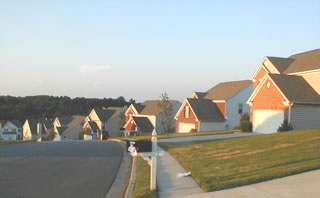 Between 1950 and 1953, seventeen thousand five hundred homes were built on former
farmland creating something that looked like a human hive from the air. These cookie
cutter type homes were supposed to be the best of American life all rolled up
into one community away from the work place. The result was the community of Lakewood,
the quintessential 1950's suburb and the direct ancestor of subdivisions being built
across Southern California today. For newcomers, Lakewood meant a new life and a fresh
start.
Suburbs are places where a whole class of Americans invented themselves. Beginning in
the mid-1950's, tens of thousands, hundreds of thousands and ultimately millions of
working class Americans, not exclusively white but of all complexions and creeds,
found enough space, enough opportunity, enough employment to lead decent lives. Those
decent lives occurred in a place called suburbia.
Suburb (Arial View)
Between 1950 and 1953, seventeen thousand five hundred homes were built on former
farmland creating something that looked like a human hive from the air. These cookie
cutter type homes were supposed to be the best of American life all rolled up
into one community away from the work place. The result was the community of Lakewood,
the quintessential 1950's suburb and the direct ancestor of subdivisions being built
across Southern California today. For newcomers, Lakewood meant a new life and a fresh
start.
Suburbs are places where a whole class of Americans invented themselves. Beginning in
the mid-1950's, tens of thousands, hundreds of thousands and ultimately millions of
working class Americans, not exclusively white but of all complexions and creeds,
found enough space, enough opportunity, enough employment to lead decent lives. Those
decent lives occurred in a place called suburbia.
Suburb (Arial View)
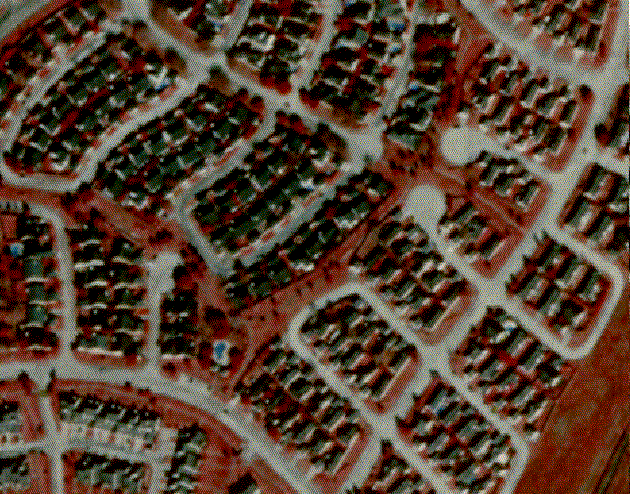 Experts worry about the wide spread sprawl which continues to spread, and these experts
and many citizens worry about the long-range costs of rapid growth. When you're driving
along the freeway and you look over and there's a new development project here and a new
development project there, it's the unplanned nature of this growth that's the concern.
Suburb House
Experts worry about the wide spread sprawl which continues to spread, and these experts
and many citizens worry about the long-range costs of rapid growth. When you're driving
along the freeway and you look over and there's a new development project here and a new
development project there, it's the unplanned nature of this growth that's the concern.
Suburb House
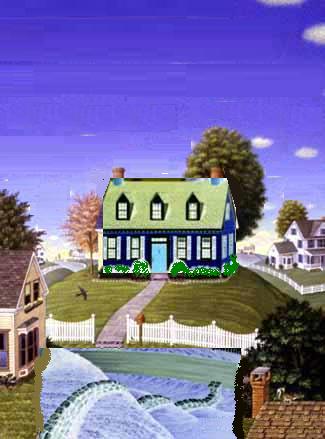 We live in this fantasy world where we have this attitude where there will be
an endless supply of energy and of land. The endless supply of water, endless supply
of land, endless supply of resources to continue to do what we've been doing for the
past two and three generations seems to be full speed ahead. The fact of the matter
is, that kind of thinking is going to suffocate us. It's going to suffocate us in terms
of the air we breath, the contamination of the water that we're trying to drink and the
land that we actually are not being very good stewards of our environment.
In the Inland Empire, Southern California, time spent by commuters in traffic has
grown from nine hours a year in 1982 to fifty-seven hours today, a more than five
hundred percent increase. Less measurable than the environmental costs of sprawl,
but just as significant, are the social costs of growth. Many worry about the spread
of so-called cookie cutter communities and the decline of civic identity. People
are leaving downtown to live in these cookie cutter environments, which degrades
the quality and life of the downtown community.
Suburb Neighborhood
We live in this fantasy world where we have this attitude where there will be
an endless supply of energy and of land. The endless supply of water, endless supply
of land, endless supply of resources to continue to do what we've been doing for the
past two and three generations seems to be full speed ahead. The fact of the matter
is, that kind of thinking is going to suffocate us. It's going to suffocate us in terms
of the air we breath, the contamination of the water that we're trying to drink and the
land that we actually are not being very good stewards of our environment.
In the Inland Empire, Southern California, time spent by commuters in traffic has
grown from nine hours a year in 1982 to fifty-seven hours today, a more than five
hundred percent increase. Less measurable than the environmental costs of sprawl,
but just as significant, are the social costs of growth. Many worry about the spread
of so-called cookie cutter communities and the decline of civic identity. People
are leaving downtown to live in these cookie cutter environments, which degrades
the quality and life of the downtown community.
Suburb Neighborhood
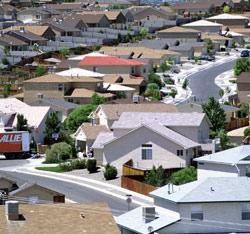 You can literally get lost in a cul-de-sac of some development project, not know what
street you're on, not know what city you're in because everything looks the same.
It's basically garage door after garage door after garage door. You feel isolated. You
feel detached. There's no sense of place. People feel like, you know, I push the button,
I put my car in the garage. I push the button and I'm home. The garage door stays
shut until it is back to work for the 5:00 am two hour commute. The gardeners are
running their equipment from sun up to sun down and you barely know your neighbor
unless you meet them at the occasional garage sale in which you can rummage through
their junk to see if they have anything different than what you already have.
Don't forget the cookie cutter strip centers. Each with a Starbucks on every corner.
Holt Woods Community
You can literally get lost in a cul-de-sac of some development project, not know what
street you're on, not know what city you're in because everything looks the same.
It's basically garage door after garage door after garage door. You feel isolated. You
feel detached. There's no sense of place. People feel like, you know, I push the button,
I put my car in the garage. I push the button and I'm home. The garage door stays
shut until it is back to work for the 5:00 am two hour commute. The gardeners are
running their equipment from sun up to sun down and you barely know your neighbor
unless you meet them at the occasional garage sale in which you can rummage through
their junk to see if they have anything different than what you already have.
Don't forget the cookie cutter strip centers. Each with a Starbucks on every corner.
Holt Woods Community
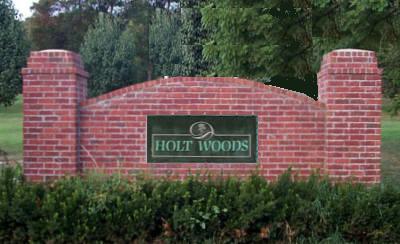 Today the most affluent suburbs are often populated by "relos," executive nomads
who move every few years to keep their careers on track, never putting down roots,
never investing in the community beyond the gated neighborhoods in which they own
their homes. "There's no there there," said Gertrude Stein; the American suburb is
still the definitive "no place," an empty parking lot sitting where our past and
future should be. The owner of the home comes home to sleep and that is about it.
Summers are spent out of the country on business trips or on European vacations which
are a write off for potential time share purchases.
Status Seekers
Today the most affluent suburbs are often populated by "relos," executive nomads
who move every few years to keep their careers on track, never putting down roots,
never investing in the community beyond the gated neighborhoods in which they own
their homes. "There's no there there," said Gertrude Stein; the American suburb is
still the definitive "no place," an empty parking lot sitting where our past and
future should be. The owner of the home comes home to sleep and that is about it.
Summers are spent out of the country on business trips or on European vacations which
are a write off for potential time share purchases.
Status Seekers
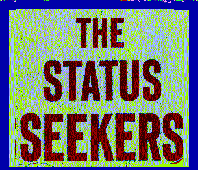 As children grow up they cannot afford the, "good life" of the American Suburb,
so they must stay in an Apartment or move to the outlying desert areas in which
dirt isn't so expensive and houses can still be bought without using the 40 year
mortgage in order to qualify.
More than half of all Americans live in suburbs as revealed in the 2000 U.S. Census.
The American Suburb defines the links between the family and their home's architecture
and landscape. The suburban house hubs are what drew the people from the inner city,
besides that of wanting a backyard; the kitchen, the porch and the patio; the first
transportation grids made suburbs a home destination for those working in the cities.
Suburbia
As children grow up they cannot afford the, "good life" of the American Suburb,
so they must stay in an Apartment or move to the outlying desert areas in which
dirt isn't so expensive and houses can still be bought without using the 40 year
mortgage in order to qualify.
More than half of all Americans live in suburbs as revealed in the 2000 U.S. Census.
The American Suburb defines the links between the family and their home's architecture
and landscape. The suburban house hubs are what drew the people from the inner city,
besides that of wanting a backyard; the kitchen, the porch and the patio; the first
transportation grids made suburbs a home destination for those working in the cities.
Suburbia
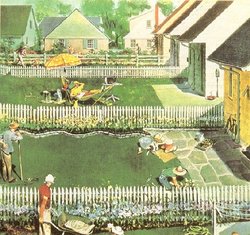 Many TV series in the 1950's through 1970's highlights the golden age of the American
suburb with its myths and stereotype of a perfect utopia. The early suburban life such
as garden clubs and horticultural societies, the great planting craze, and the origin of
antiquing.", and the rise of carpentry as a hobby."-- was all the suburbanite craze.
The prize Rose Garden and a perfect lawn are held in prize esteem.
To be in the suburbs meant buying into the American Dream of owning one's own home
and planting roots in a community. The do it yourself movement, and the origins of
the come outer (commuter) grew from the suburb traditions. All of these movements
challenges our assumptions about what constitutes a good life. This is complete
with soccer moms in giant SUV's and the trivial concerns of "sanctimonious
suburbanites". As American cities grew more crowded and more heterogeneous, city
officials, planners, developers, and house owners sought to preserve home
environments."
Of course, family life is at the middle of any support system and to preserve a
happy healthy family in a middle class lifestyle cannot be scorned upon nor
made fun of because this is what we all strive for in the end. You get as much
out of a suburb as you put into it so that there does not have to be a
misconnection with other human-beings. It's just a matter of setting one's
priorities. Please don't forget to support what the inner city has to offer,
because it is usually the hub for art and character in each community.
The cul-de-sac is a constantly evolving neighborhood community. It's a newcomer's
God-given right to live in a brand-new tract home on a cul-de-sac, grass lawn with
a date palm included. The developer tries to build to the American dream, whether
real or imagined. It seems like more upwardly mobile cul-de-sac people bring with
them all of the trappings of the middle class leisures. The front garden of an older
track home becomes a parking space for the recreational vechicle and more cement is
needed for that speed boat that is used twice during the summmer. This is a good
place to raise kids do to the dead-end curb appeal in which cars seldom reach the
end of the street. The definition of the cul-de-sac is a dead end street which
widens sufficiently at the end to permit an automobile to make a "U" turn.
Reflecting neighborhood character is not as important a function as mobility with
the cul-de-sac. It is Backbone to pedestrian and bicycle networks which carries
only traffic that originates or has its destination on that street. These areas
are sometimes self patrolled by the neighborhood watch group which is a self
monitoring system of your neighbors property.
Neighborhood Watch
Many TV series in the 1950's through 1970's highlights the golden age of the American
suburb with its myths and stereotype of a perfect utopia. The early suburban life such
as garden clubs and horticultural societies, the great planting craze, and the origin of
antiquing.", and the rise of carpentry as a hobby."-- was all the suburbanite craze.
The prize Rose Garden and a perfect lawn are held in prize esteem.
To be in the suburbs meant buying into the American Dream of owning one's own home
and planting roots in a community. The do it yourself movement, and the origins of
the come outer (commuter) grew from the suburb traditions. All of these movements
challenges our assumptions about what constitutes a good life. This is complete
with soccer moms in giant SUV's and the trivial concerns of "sanctimonious
suburbanites". As American cities grew more crowded and more heterogeneous, city
officials, planners, developers, and house owners sought to preserve home
environments."
Of course, family life is at the middle of any support system and to preserve a
happy healthy family in a middle class lifestyle cannot be scorned upon nor
made fun of because this is what we all strive for in the end. You get as much
out of a suburb as you put into it so that there does not have to be a
misconnection with other human-beings. It's just a matter of setting one's
priorities. Please don't forget to support what the inner city has to offer,
because it is usually the hub for art and character in each community.
The cul-de-sac is a constantly evolving neighborhood community. It's a newcomer's
God-given right to live in a brand-new tract home on a cul-de-sac, grass lawn with
a date palm included. The developer tries to build to the American dream, whether
real or imagined. It seems like more upwardly mobile cul-de-sac people bring with
them all of the trappings of the middle class leisures. The front garden of an older
track home becomes a parking space for the recreational vechicle and more cement is
needed for that speed boat that is used twice during the summmer. This is a good
place to raise kids do to the dead-end curb appeal in which cars seldom reach the
end of the street. The definition of the cul-de-sac is a dead end street which
widens sufficiently at the end to permit an automobile to make a "U" turn.
Reflecting neighborhood character is not as important a function as mobility with
the cul-de-sac. It is Backbone to pedestrian and bicycle networks which carries
only traffic that originates or has its destination on that street. These areas
are sometimes self patrolled by the neighborhood watch group which is a self
monitoring system of your neighbors property.
Neighborhood Watch
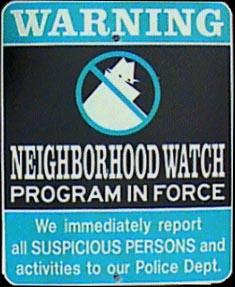 Neighborhood Watch is simply a program of neighbors watching out for each other during
the workday, evenings, vacations or any other absence. The purpose of the Neighborhood
Watch program is to create an alert neighborhood by using simple crime prevention
methods. The program works through the mutual aid of neighbors watching the property
of other neighbors. This has several advantages, including the fact that your neighbors
know who you are, what type of car you drive, and who belongs.
People will pay more for the cul-de-sac because it represents a quite residential
community neighborhood in which it is possible to get to know one's neighbors and
to find a since of community within the neighborhood. Hoping for the kids sleep
overs, birthday celebrations and pool parties which bring a unity to the neighborhood.
All this with a good school district and a Country Club nearby for local tennis,
swimming and golf lessons. These lots are generally much larger than the rest of the
neighborhood giving lots of space for the swing-set and pool.
The Suburbs were deliberately planned to maximize consumption of mass-produced
goods and minimize the responsibility of the developers to create public space and
public services. Suburbia promises the dream of home, nature and community
for those escapees of the urban landscape who yearned for backyards and a sense
of the good life.
What isn't mentioned is that the aging cul-de-sac community becomes desolate
once the kids leave and the empty nesters are left with their 2000 plus square
foot homes. Topics of conversation change from, what is the best school, to that
of who is the best Doctor and what is new with AARP? The home owners disappear
into their large indoor living space and the neighborhood is most enjoyed by the
teams of gardeners, pool cleaners and maids wbo make their way to these suburbs
from their urban rental apartments to upkeep these large spaces that are hardly
seen by retiring professional. Life is not brought back into these neighborhoods
until the eventual turnover of these properties, when once again their is laughter
and hopscotch in the area. Unfortunately, with the excessive price of the
suburban neighborhood, it is unlikely that any starter family could afford to
start in a well placed cul-de-sac, which is close to shopping and to the freeway
because it takes more than $100,000 a year to qualify in many of these areas.
As a result, the neighborhood community is made up of mostly middle-aged professionals
who are to busy to appreciate their neighbor or neighborhood.
Cul-de-sac (Sold Out - Unavailable)
Neighborhood Watch is simply a program of neighbors watching out for each other during
the workday, evenings, vacations or any other absence. The purpose of the Neighborhood
Watch program is to create an alert neighborhood by using simple crime prevention
methods. The program works through the mutual aid of neighbors watching the property
of other neighbors. This has several advantages, including the fact that your neighbors
know who you are, what type of car you drive, and who belongs.
People will pay more for the cul-de-sac because it represents a quite residential
community neighborhood in which it is possible to get to know one's neighbors and
to find a since of community within the neighborhood. Hoping for the kids sleep
overs, birthday celebrations and pool parties which bring a unity to the neighborhood.
All this with a good school district and a Country Club nearby for local tennis,
swimming and golf lessons. These lots are generally much larger than the rest of the
neighborhood giving lots of space for the swing-set and pool.
The Suburbs were deliberately planned to maximize consumption of mass-produced
goods and minimize the responsibility of the developers to create public space and
public services. Suburbia promises the dream of home, nature and community
for those escapees of the urban landscape who yearned for backyards and a sense
of the good life.
What isn't mentioned is that the aging cul-de-sac community becomes desolate
once the kids leave and the empty nesters are left with their 2000 plus square
foot homes. Topics of conversation change from, what is the best school, to that
of who is the best Doctor and what is new with AARP? The home owners disappear
into their large indoor living space and the neighborhood is most enjoyed by the
teams of gardeners, pool cleaners and maids wbo make their way to these suburbs
from their urban rental apartments to upkeep these large spaces that are hardly
seen by retiring professional. Life is not brought back into these neighborhoods
until the eventual turnover of these properties, when once again their is laughter
and hopscotch in the area. Unfortunately, with the excessive price of the
suburban neighborhood, it is unlikely that any starter family could afford to
start in a well placed cul-de-sac, which is close to shopping and to the freeway
because it takes more than $100,000 a year to qualify in many of these areas.
As a result, the neighborhood community is made up of mostly middle-aged professionals
who are to busy to appreciate their neighbor or neighborhood.
Cul-de-sac (Sold Out - Unavailable)
 End of the Road!
Thank you for taking a look at the Suburbs.
End of the Road!
Thank you for taking a look at the Suburbs.
